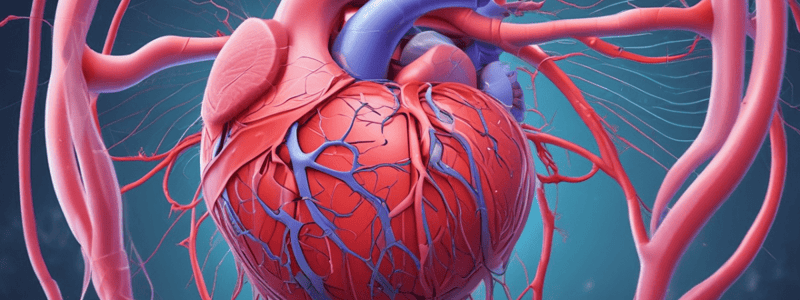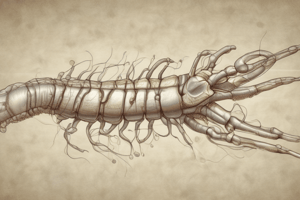Podcast
Questions and Answers
What is the relationship between end-diastolic volume and stroke volume according to the Frank-Starling law?
What is the relationship between end-diastolic volume and stroke volume according to the Frank-Starling law?
- The end-diastolic volume has no effect on stroke volume.
- The greater the end-diastolic volume, the greater the stroke volume. (correct)
- The greater the end-diastolic volume, the smaller the stroke volume.
- The end-diastolic volume and stroke volume are unrelated.
What is the purpose of the Frank-Starling mechanism?
What is the purpose of the Frank-Starling mechanism?
- To increase end-systolic volume.
- To increase venous return.
- To increase the volume of blood pumped out during systole. (correct)
- To increase contractility.
What is the effect of increased contractility on end-systolic volume?
What is the effect of increased contractility on end-systolic volume?
- Increased contractility can either increase or decrease end-systolic volume.
- Increased contractility has no effect on end-systolic volume.
- Increased contractility leads to an increase in end-systolic volume.
- Increased contractility leads to a decrease in end-systolic volume. (correct)
What is the formula for stroke volume?
What is the formula for stroke volume?
What is the effect of increased contractility on stroke volume?
What is the effect of increased contractility on stroke volume?
What is the relationship between preload (end-diastolic volume/fiber length) and diastolic filling?
What is the relationship between preload (end-diastolic volume/fiber length) and diastolic filling?
What is the definition of stroke volume?
What is the definition of stroke volume?
What does ejection fraction measure?
What does ejection fraction measure?
What is the formula for calculating cardiac output?
What is the formula for calculating cardiac output?
Which of the following factors can increase cardiac output?
Which of the following factors can increase cardiac output?
Which of the following is not an intrinsic factor affecting cardiac output?
Which of the following is not an intrinsic factor affecting cardiac output?
What is the Frank-Starling mechanism?
What is the Frank-Starling mechanism?
What is the primary endogenous agonist that activates M2 receptors in the heart?
What is the primary endogenous agonist that activates M2 receptors in the heart?
Which receptor activation leads to an increase in automaticity (heart rate) in cardiovascular physiology?
Which receptor activation leads to an increase in automaticity (heart rate) in cardiovascular physiology?
Which neurotransmitter is released from postganglionic neurons and slows down the discharge rate of the SA node?
Which neurotransmitter is released from postganglionic neurons and slows down the discharge rate of the SA node?
What effect does inhibition of the cAMP pathway have on cardiac HR and output?
What effect does inhibition of the cAMP pathway have on cardiac HR and output?
Which system predominates in the heart but acts in a reciprocal manner with the other system?
Which system predominates in the heart but acts in a reciprocal manner with the other system?
What is the direct correlation between contractility and intracellular calcium concentration?
What is the direct correlation between contractility and intracellular calcium concentration?
Which of the following extrinsic factors increases contractility?
Which of the following extrinsic factors increases contractility?
How do epinephrine and norepinephrine affect contractility?
How do epinephrine and norepinephrine affect contractility?
What is the afterload for the left ventricle?
What is the afterload for the left ventricle?
What happens when aortic blood pressure increases?
What happens when aortic blood pressure increases?
What is the primary mechanism by which epinephrine and norepinephrine increase contractility?
What is the primary mechanism by which epinephrine and norepinephrine increase contractility?
What is the primary effect of the Anrep effect?
What is the primary effect of the Anrep effect?
What is the mechanism behind the Anrep effect?
What is the mechanism behind the Anrep effect?
What is the relationship between afterload and stroke volume?
What is the relationship between afterload and stroke volume?
What is the primary determinant of cardiac output?
What is the primary determinant of cardiac output?
What is the effect of sympathetic activity on cardiac output?
What is the effect of sympathetic activity on cardiac output?
Which branch of the autonomic nervous system predominates in the heart?
Which branch of the autonomic nervous system predominates in the heart?
Study Notes
Frank-Starling Mechanism
- The greater the end-diastolic volume, the larger the stroke volume
- The more the heart is stretched, the longer the initial cardiac fiber length before contraction
- Increased length leads to a greater force of contraction and a greater stroke volume
Contractility (Inotropism)
- Refers to the pumping ability of a ventricle
- Intrinsic ability of myocardial cells to develop force at a given muscle cell length
- An increase in contractility leads to a more complete emptying of the ventricle during systole
- Decrease in end-systolic volume and increase in stroke volume
Afterload
- The Anrep effect: allows myocardium to compensate for an increased end-systolic volume and decreased stroke volume that occurs when aortic blood pressure increases
- Increase in afterload stimulates the release of catecholamines, which causes an increase in ventricular contractility (inotropy)
Heart Rate and Cardiac Output
- Heart rate is affected by the autonomic nervous system
- Parasympathetic activity predominates in the heart
- Cardiac output is the total volume of blood pumped by the heart per minute
- Cardiac output = stroke volume x heart rate
Stroke Volume and Ejection Fraction
- Stroke volume is the volume of blood ejected out of the left ventricle during each systolic cardiac contraction
- Ejection fraction is the fraction of the end-diastolic volume that is ejected in one stroke volume
- Normally around 60% (0.6)
- Increase in ejection fraction reflects an increase in contractility
Autonomic Nervous System and Heart Function
- Sympathetic activity increases heart rate and contractility
- Parasympathetic activity slows down heart rate and decreases contractility
- M2 receptors in the heart are inhibited by acetylcholine, which slows down the heart rate and decreases contractility
- Beta 1 receptor activation increases contractility and heart rate
Studying That Suits You
Use AI to generate personalized quizzes and flashcards to suit your learning preferences.
Description
physio 1




